
Magic Meeting – A deade on!
The exhibition “Magic Meeting – A Decade On!” by Libia Castro and Ólafur Ólafsson in Hafnarborg opened on the 20th of March 2021. The exhibition is a continuation of the multivocal music, visual art and activist performance „In Search of Magic – A Proposal for a New Constitution for the Republic of Iceland” that took place on the 3rd of October in the Reykjavik Art Museum, Hafnarhúsið, continued out on the streets, in front of the Prime Minister’s office ending in Austurvöllur public square in front of the parliament. The event was made in collaboration and co-produced with Cycle Music and Art Festival and was part of the program of the Reykjavik Art Festival. The performance is the most memorable art event of the year and was a collective work on a huge scale between the artists Libia & Ólafur, the curators Guðný Guðmundsdóttir and Sunna Ástþórsdóttir, well known composers and musicians, activists in The Constitutional Association, Women for The Constitution and environmentalists, graphic artists, technicians and others. See Cycle.is for a full list of collaborators. The duo was awarded the Icelandic Art Prize 2021 for their collective performance.
The exhibition in Hafnarborg comprises works of the last decade in relation to the constitution of Iceland, and a new multimedia immersive environment with a video installation at its center created with works from the performance made on Oct 3rd and a new video work documenting the entire happening edited to archive images from tv and other film sources of the last decade. Those artworks are not their first to address civic rights or politics or include collaboration with other artists. Libia and Ólafur live and work in Iceland, Berlin Germany, Rotterdam Holland and Málaga in Spain, and their work has been exhibited internationally among other in Manifesta 7, TENT Rotterdam, 54th Venice Biennial, The National Gallery in Oslo, CAAC Seville and Kunst-Werke, Berlin. The performance „In Search of Magic…” is probably one of the artists’ biggest collective works in its scale, with around 150 participants and brings to life all the 114 articles of Iceland’s new constitutional proposal.
The Reykjavik Art Museum was referred to as a music hall that day but also filled with textiles, action banners and flags. It was set up as an immersive environment shared by performers, activists and the public. Huge disco balls and lighting amplified the atmosphere which was monumental and playful at the same time, as well as filled with solidarity and hope. Each musician, band or music group performed their chapter of music in different spots in the big museum hall in the form of punk rock, classical contemporary compositions, children’s choir, electronics, folk music or other genres. Sung, spoken or rapped chapters of the new constitution, performed in Icelandic, Polish and Filipino for full 4 hours.
Most of the performers had on hoodies or T-shirts with printed images of slogans related to the New Constitution. The audience was led to the balconies in covid restricted groups but people were able to stay there for a certain period of time. After the event inside the museum, the artists and performers with the activists came carrying the huge banners outside where they joined forces with a big group of audience and participants, activists and artists. People started walking with the banners, seen and filmed from within and from the air, with camera operators and with cell phones from the participating crowd. A leading person was using a megaphone and the group´s voices used as responsive protest in choir to present their claim. The parade stopped in front of the Prime Minister’s office and went from there to Austurvöllur square where speeches were held, articles were musically performed and a huge monumental banner was pulled up with a crane in front of the house of parliament, Alþingi, letting the building frame the work. The message was simple but like a screaming fuchsia-pink sticky-note, stating “ The New Constitution Thanks!”.
A video with the „Introductionary words“ song and lyrics: Lay Low.
The exhibition in Hafnarborg is an overview with older and new works from the project on the new constitution and its predecessors. Exhibited among others are textile works/banners from the performance, the monumental banner that was lifted in front of Althingi, sketches and colorful works, entitled Visual Scores, depicting the music fusion. Pots and pans are located at various places reminding us of the social background scenario where the New Constitution was originated. The video work at the center of the installation documents the performance, also edited and juxtaposed to filmed archive material from RUV (The Icelandic National Broadcasting Service) and other sources from the last decade, in relation to the New Constitution, the environmental struggle and representing relevant moments in Icelandic society in the aftermath of the 2008 economic crisis. Guests can also sit down with a remote control in a separate room installed like a living room situation and scroll through the video work for selective chapters. The groundfloor´s exhibition space of the museum has been used as an open project space in progress lately, where workshops have been held during the exhibition time, talks, presentations and assemblies and at the entrance lobby there is a pop up shop selling T-shirts, bags and printed second hand clothing stating the claims regarding the new constitution. The art will probably be meeting the politics again in sone form like it did in their show in Gerðarsafn in 2017 in an event in the end of the exhibition time.
Artzine interviewed Libia and Ólafur and asked them about the last decade, the conversation between art and activism and how the artistic battle for the new constitution had to overcome covid restrictions again and again and maybe even silencing. And where this joy for collective work and the interest in working with civic rights, sociopolitical critical issues comes from?
Collaboration and influence:
Libia: We have been inspired by various artists throughout our dialogue. We were for example very inspired by South American artistic practices in Chile in the 70’s and 80’s and in Brazil with neo concretism and what was developed after that, also by fluxus as an international interdisciplinary art movement bridging the West and Asia. In Europe the situationists were very, very important for us, having been critical earlier. They were sociopolitically engaged in their practice as well as collaborative in their work. They were poets and architects in a collective with visual artists which I think is what has inspired us the most. If you are working with life and life processes as a collective and with sociopolitical critical issues it is very difficult to focus on your work from a single narrow perspective or the use and research through one medium only. The outcome will not only be visual arts but visual arts in dialogue with music, philosophy, performance art, journalism and so on. Also form and aesthetics will be questioned and re-shaped by the intersection and the experimentation between different disciplines and the content´s research, though in our case conceptual and visual art is the discipline we operate from and expand.
The process and concept:
L: We started on the first work regarding this issue in 2007 the idea was to make the content of the old constitution public through art. To appropriate and decontextualize all the articles of the constitution and give them new life and context through art and music by looking at them estranged from their original juridical context. Also making them accessible to a wide public, unlocking them to new associations through a musical performance. The work had two moments of production. The first one was the musical performance of the constitution in a contemporary classical version in collaboration with the composer Karolina Eiríksdóottir, in march 2008 at the music hall Ketilhúsið in Akureyri. It was part of the exhibition “Bye, Bye Iceland“ in the Akureyri Art museum. In the autumn of 2008 when the financial crash took place we were thinking that we still wanted to make this artwork really public, beyond the context of art and the music world presenting it in mass media – on television.
Ólafur: At that point it was not really possible. We had tried to get the television to broadcast live from the performance but they were not at all interested. They did respond afterwards so they must have been intrigued. They contacted us and called the museum and asked if it had been filmed. Then we sent them a video fragment of 3 minutes and that was broadcasted as a news item. Art has hardly been displayed in the news and for decades it has only appeared in news as the outro at the end of it, with the text running over it and they would play some unrelated music while it scrolled down. The fact that this artwork made the news was news in itself. Then actually the radio was very interested afterwards also and asked if they could play the entire piece on radio. We said no to that, knowing it would reduce the chance of it being broadcasted in television. Also because we are visual artists and we wanted it to be understood that way. We agreed to a long program about it on the radio though. Big part of it was broadcasted and they interviewed us and Karolina. Part of the music became theme music to a program that Ævar Kjartansson and Jón Ormur made later about constitutional matters. L: In 2011 we did the second part of the production. After the economic crash and the constitutional council had been elected and appointed and the new constitution was about to be written, Ólöf K. Sigurðardóttir invited us a solo exhibition in Hafnarborg. In that show we could finally produce the music video of the musical performance in collaboration with RUV. Then of course the issue of the constitution was out there and RUV was interested. It also helped that we were going to exhibit at The Venice Biennial that year.
Then the public meeting and debate in Gerðarsafn 2017 was held on the five years anniversary of the New Constitution as an event in our installation, in the group exhibition Sovereign | Colony organized by Cycle Music and Art Festival. In the show we exhibited original documents of the constitution from 1874, 1920, and 1944 as well as a print of the Danish version from 1849 and multiple copies of the New Constitution implemented in 2011.
It was an important meeting point for us. We were setting on the foundation for the project to grow. We were also inspired by the fact that the new constitution is written in another political and historical heightened context which is the aftermath of the crash in 2008. It is written by this heterogeneous constitutional council, a collective of 25 pre-elected people. We felt that it was so important. We wanted to make the content of the new constitution public again through art and using the art context and see what people felt about it and contribute to the debate so it wouldn’t be forgotten. For us that meeting was very meaningful and important in this process of letting activism and art meet. We will make a symposium / assembly in the end term of the exhibition in Hafnarborg as well so it´s like a cycle now.
The new project is in tandem with what’s going on in society here in relation to the new constitution, the politics of silencing it and what’s happening within the Constitutional Association and the Women for the New Constitution, the activists that are resisting and caring about it, being active all this time keeping it alive and relevant to the public and within political discussion. The last couple of years the movement for the new constitution has grown exponentially again. We joined that movement in 2017 and at the same time we started to develop the idea of putting music to all the articles of the constitution, making a performance in relation to the first work, but this time as an activist-artist project.
Textile work or protest banners?
Ó: I realised recently that the origin of our textile artwork mania is from the precise moment of the 22nd of September 2017 when we were making the wall painting in Gerðarsafn. The text was the date of the public election on the New Constitution painted on the wall but later it became a banner to be used as a backdrop on the stage that Hörður Torfa and the Constitutional Association were using in front of the parliament house, where we started gathering again every weekend in meetings and protest. Now we have turned wall paintings into a mobile applicable artifact and it has exploded into a multiplicity of textile works.
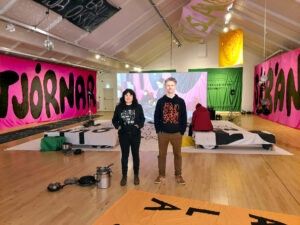

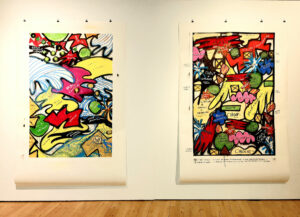
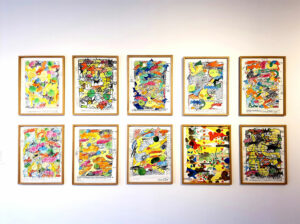
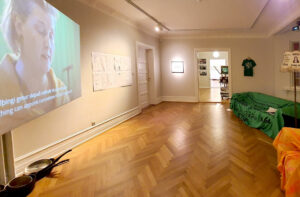
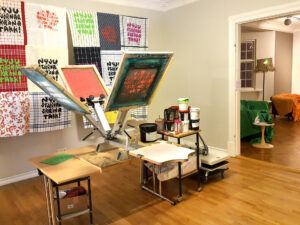


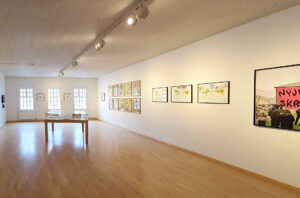

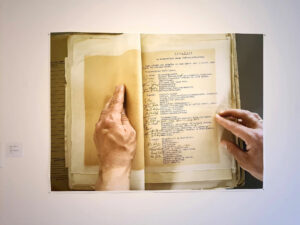
Musical high-culture and low-culture:
Ó: For the first performance in 2008 we chose to use classical contemporary music for two reasons. One is simply that the format of classical contemporary music is elastic enough you can stretch it out timewise as you want like when you are working with 8 pages of text. Another reason is that classical music would be categorized as “high-culture”. We had only two instruments, contrabass and piano and then voices. There was a deliberate decision to match what is considered high end to the content and experiment with it, partly subvert it. It should be the highest valued music genre as the matter itself was highly valued and at the same time we wanted a popular platform for the video, public television, to reach a wide audience. In the later work we wanted to have another approach, diversity and inclusion. We failed to include all genres of music that exist hahaha, but we had quite a few, working with a multiplicity of composers and musicians and trying to instigate as much collaboration as possible, inclusion and dialogue.
L: We started working with nine composers and we made three groups of three so they were collaborating within as well. We decided not to work on the chapters linearly but to take the articles from 1 to 114 and cut them up and mix them and choose them by chance. By splitting all the articles and taking them by chance there would not only be a collage of different juxtaposed songs together when putting them back again in their linear order, but also threads and fragments connecting throughout the whole collective composition.
The pandemic:
Ó: When we originally started working on the performance in Berlin and when we were trying out some of the first ideas with the composers in Iceland in the autumn of 2019, we had no idea of what would come. Then we were thinking of including 800 people in the work as well as the public. Later we had the issue “will we be able to do it at all because of Covid?”.
L: We can not see the project out of the context of Covid. That has been such a crazy element to work with and around. We had to change quite some because of it. Still we were able to do it and maintain all the fundamental elements we wanted. We did not have any frontal staging, performers, activists, technicians, film, sound and operators. The public would share the whole floor, all balconies and perspectives, be spread and move, occupying the entire space. We did maintain that in the installation and the staging of the performers, technicians and some of the activists, which were also an audience, but the public was separated into one side of the balconies, restricting their position and view to the aerial perspective from one side of the courtyard only. The monumentality and immersion of it and the idea of otherwise shared space and moving perspectives was there. The music and sound was also coming at different times from different places, or synchronously from the different directions. 30 people could enter every 30 minutes, keeping a meter distance from each other. Since it was a durational performance the audience could at least rotate and experience a part of it. Everybody was wearing masks, and guardians and helpers became part of the performance. We had also planned on bringing in other artists from other parts of the country and abroad but Covid hindered us and the performance date was even moved from June to October. In October we almost had to cancel it, but we decided all together to work with the limitations, something that was very important for an art and activist event in a moment of campaigning.
The collective and scale:
L: We had two curators collaborating and co-producing with us; Guðný Guðmundsdóttir based in Berlin, coming from a music background and being the director of Cycle Music and Art festival and Sunna Ástþórsdóttir in Reykjavik, coming from the visual arts, working at The Living Art Museum. The process was both very structured and also very organic, including the wonderful chaos that COVID had brought over all of us. In the beginning we were a small team of 4 people but then we grew exponentially when we started the communication and work with the composers, the activists, the musicians, with the Reykjavik Art Museum, the Reykjavik Art Festival, RUV, the film and sound team so it was crazy multi tasking and overwhelming at times.
There were also gaps in between but it was a process of two and half years, and last year though it was “on“ all the time, at times it was also just “off” because of Covid. The collaboration was widespread with different action and production groups. We were working with a process that is alive and having its own life. It demanded that big scale because the subject is on that kind of scale in society. We are talking about the laws and the juridical foundation of a country, but also about the most groundbreaking and democratic civil process that has taken place in Iceland in decades, which was the rewriting of the new constitution in the aftermath of the economic crisis of 2008, the so called Crowdsourced Constitution.
The movement we are a part of which demands its implementation and works against its silencing and forgetfulness, has shrunk at times and then at times it can blow up and become much bigger. That’s how it is with activism and movements. There is a contingency, a trigger and if you are ready all can grow again exponentially and things that have been locked can change and evolve again. Then there are other times where five people are resisting and pushing, keeping the flame going, away from suffocating. We also felt that the work would have to be as public and on this big of a scale as to match its reality and the movement has only been growing these last couple of years. We were anchoring the musical performance in a visual art context that is the museum, being a living artform and a living image, as a ritual in commoning and remembering together, but also becoming a happening as an action and civil protest. First occupying the museum then leaving it with part of the stage, with the art works and the magic, and continuing the dance and chanting out on the streets, acting and intervening in front of the Prime Minister’s Office and the Parliament House on the public square.
Activism or art:
L: It is actually both things together and that is perfectly possible.
Ó: The definition of what is art doesn’t exist as something eternal or rigid the same goes for the ways of activism – , art is always in a construct and exists in a consensus, in relation to culture, ideologies, hierarchies, hegemonies, history -as historic periods- etc… It’s just something we maintain, reinvent, transgress, battle, defy, de-construct, re-define when we go along.
L: Important is not to get disencourage by rigid definitions and the consensus of the time you live in and continue asking or challenging it through the experiments and the art works themselves. It is not different when we ask ourselves and question what defines the status quo, regarding who is holding hegemonic power for example and how is it being perpetuated at different times for example and whether we should change it and how if it is a source of suffering, or injustice. Art is a result of the consensus in place, but it is also a practice and an instrument to reflect on it critically, poetically, to question it and even together with other disciplines and human action contribute to disrupt and imagine it changing, and act upon it.
Silence or censorship:
Ó: It’s reasonable to wonder about various facts when it comes to the media, their responses and even at times non responses. Perhaps the broadcasting media has to decide if they are going to work with visual artists in general and if so they should have a strategy or a vision regarding that. Perhaps all the cultural institutions should look into their policy and sharpen their role in communicating and strengthening visual art. Artworks that are critical, a social satire or have a political nuance in some way should not be silenced or circumvented of fear that the institutions themselves are taking a stance.
As long as certain ethical norms are not violated artists have to have freedom in their artistic creation. We do not go so far as to say that our work has been censored by the media, but many people have wondered and felt a suspicious silence around certain parts of these works.
L: Nevertheless the outrage that it caused on social media and specifically the continuation in the media throughout the week after with all the image material we produced from the performance, gave us and the activists a lot of possibilities to continue campaigning. Which resulted in a very big increase of signatures for the public petition list that had been started by the Women for The New Constitution some months before, which was one of our aims and the reason why we all absolutely wanted to go ahead with the performance on the 3rd of October, despite all the covid restrictions we had to deal with. That turned out to be the right decision, since the next day all museums were closed and gatherings reduced to 10 people max.
Artzine congratulates Libia and Ólafur and the collective of people participating in the performance “In search of magic – A proposal for a new Constitution for the Republic of Iceland”, on receiving the Art Prize 2021. The magic of the work was partly the beautiful solidarity and artistic framing of this critical mass movement that stands behind the presentation of the claim acknowledging the new constitution.
Aftermath: The exhibition in Hafnarborg has indisputably been censored, but the Sunday 2nd of May a textile artwork or banner that the artists had hung on the facade of Hafnarborg, by permission, was removed. The work was an enlarged replica of a ticket used in the 2010 National meeting which contained the following message to the parliament „DO NOT BULLSHIT YOURSELF FROM THE RESULTS OF THE CONSTITUTIONAL PARLIAMENT”. The artists got a phone call that morning from the manager of Hafnarborg telling them that the textile artwork should be taken down by the mayor Rosa Guðbjartsdóttir request. When Libia and Ólafur came shortly after to the museum the artwork had already been taken without any consultation. They called the police as the artwork was missing and without a trace. Later a town employee of Hafnarfjörður returned the flag to them but the message was clear. The artwork should not be hanging on the facade.
This case is unique, but the artists who have exhibited all over the world, even in Cuba and Turkey, have never experienced a similar incident at the hands of a government. The case went before the town council and town council meetings and after declarations from the Icelandic department of ICOM, BÍL and others, the work was hung up again.
María Pétursdóttir
Photo credit: María Pétursdóttir. Video Libia Castro & The Magic Team.
